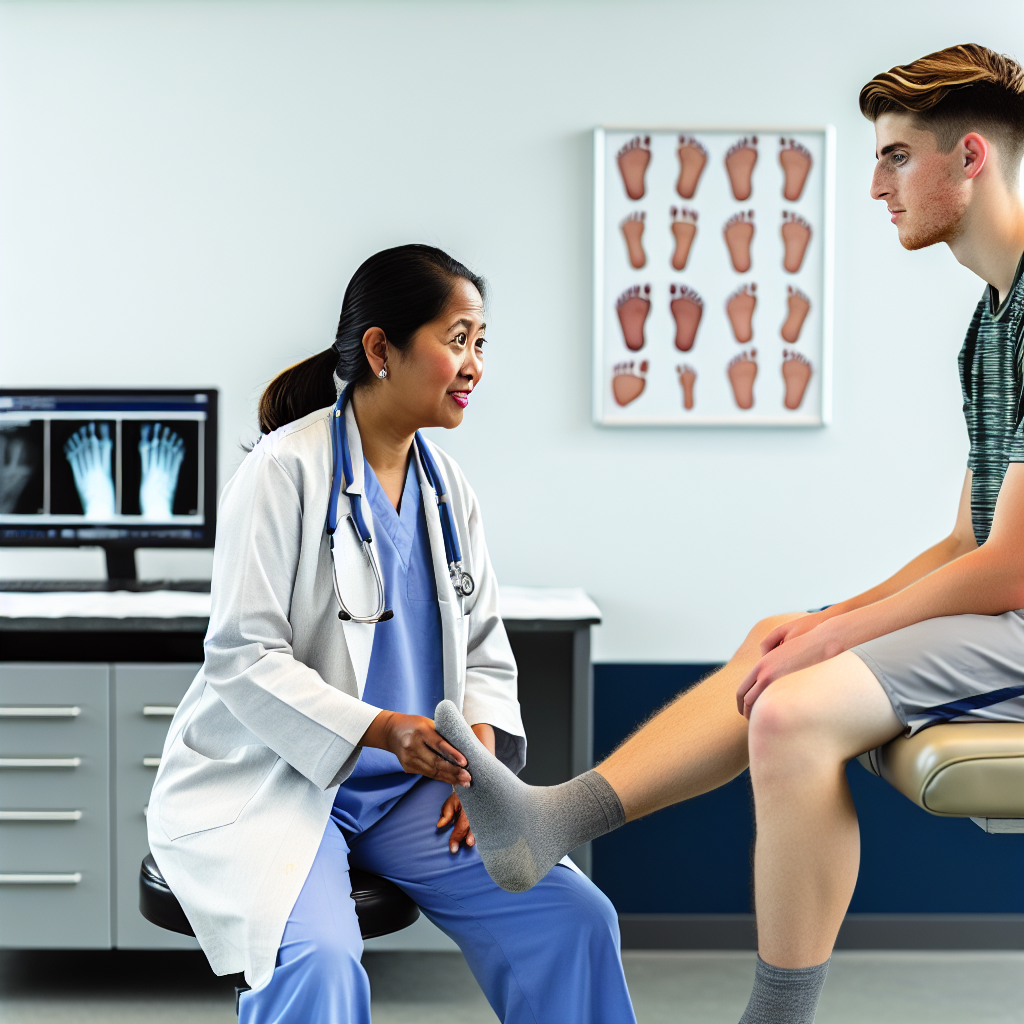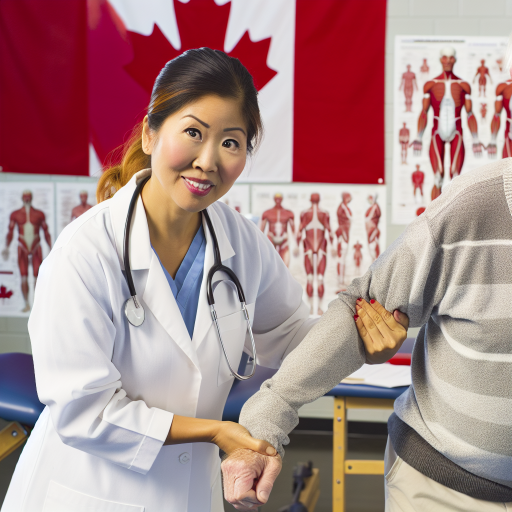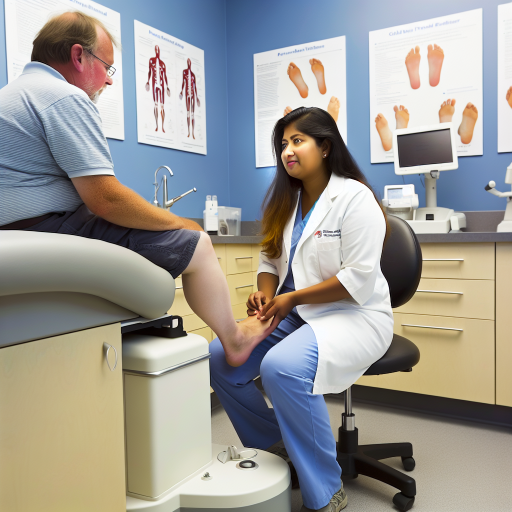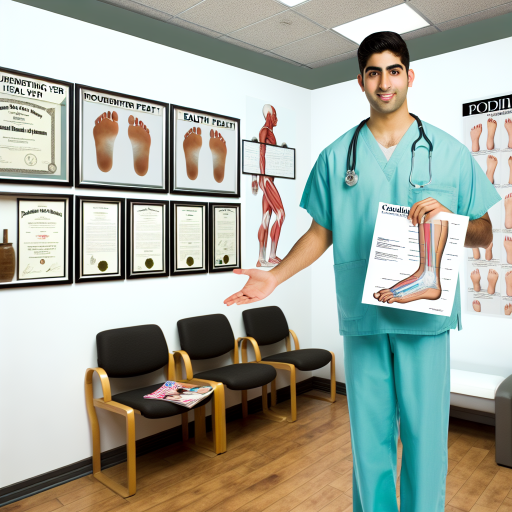The Role of Podiatrists in Athletic Performance Enhancement
Understanding Foot Mechanics
Podiatrists specialize in understanding foot mechanics and biomechanics.
They study how the foot interacts with the ground during movement.
This knowledge helps athletes achieve optimal performance.
Moreover, correct foot mechanics can prevent injuries.
Injury Prevention Strategies
Podiatrists provide athletes with personalized injury prevention strategies.
They assess each athlete’s foot structure and movement patterns.
Custom orthotics can be designed to support individual needs.
Furthermore, they recommend exercises to strengthen foot muscles.
These preventive measures are crucial for long-term athletic success.
Rehabilitation Programs
Injuries can derail an athlete’s training and performance.
Podiatrists play a vital role in rehabilitation programs.
They create comprehensive recovery plans tailored to each athlete.
Incorporating physical therapy techniques enhances recovery speed.
Thus, athletes return to peak performance more quickly.
Performance Optimization Techniques
Podiatrists assist athletes in optimizing their performance techniques.
They analyze running, jumping, and cutting patterns.
Based on the analysis, specific drills are recommended.
These drills help develop agility and coordination.
As a result, athletes can perform at their highest level.
Collaboration with Coaches and Trainers
Effective athletic support requires teamwork.
Podiatrists collaborate closely with coaches and trainers.
This partnership ensures a holistic approach to athlete care.
They share valuable insights about foot health and training methods.
Consequently, athletes receive comprehensive performance support.
Common Podiatric Injuries Among Athletes and Their Impact on Performance
Common Injuries
Many athletes experience common podiatric injuries during their careers.
Unlock Your Career Potential
Visualize a clear path to success with our tailored Career Consulting service. Personalized insights in just 1-3 days.
Get StartedUnderstanding these injuries helps in effective prevention and treatment.
Some prevalent injuries include plantar fasciitis, Achilles tendonitis, and stress fractures.
Additionally, ankle sprains and metatarsalgia are frequent among competitive athletes.
Plantar Fasciitis
Plantar fasciitis causes significant heel pain and discomfort.
This condition arises from inflammation of the plantar fascia.
Symptoms often worsen with increased activity levels.
Consequently, athletes may experience reduced performance and endurance.
Achilles Tendonitis
Achilles tendonitis presents as pain along the back of the heel.
This injury typically results from overuse or improper training techniques.
Athletes may struggle with running and jumping activities due to this ailment.
Podiatric intervention can help in rehabilitation and recovery.
Stress Fractures
Stress fractures develop from repetitive force on bones.
They commonly affect the foot and lower leg in athletes.
Signs include localized pain and swelling after physical activity.
Timely diagnosis is crucial to prevent prolonged absence from sports.
Ankle Sprains
Ankle sprains often occur during sudden movements in sports.
This injury may result in swelling and difficulty bearing weight.
Rest, ice, compression, and elevation are essential for recovery.
However, chronic ankle instability can lead to recurring injuries.
Metatarsalgia
Metatarsalgia involves pain in the ball of the foot.
This condition results from excessive pressure on the metatarsal bones.
Athletes may feel discomfort during impact activities like running.
Proper footwear and orthotics can alleviate symptoms significantly.
Impact on Performance
Podiatric injuries can greatly hinder an athlete’s performance.
Pain and discomfort limit mobility, reducing overall effectiveness.
Injured athletes may require longer recovery periods, affecting training.
Furthermore, untreated injuries can lead to chronic issues over time.
Importance of Podiatry
Regular visits to a podiatrist can prevent many common injuries.
Podiatrists provide valuable insights into biomechanics and foot health.
They assess an athlete’s footwear and provide customized recommendations.
Proper foot care is crucial for maintaining peak performance.
Preventative Care: How Regular Podiatry Visits Aid Athletic Longevity
Understanding the Role of Podiatrists
Podiatrists specialize in foot and ankle care for athletes.
They help prevent, diagnose, and treat injuries.
Moreover, their expertise enhances overall athletic performance.
Importance of Preventative Care
Regular visits to a podiatrist can significantly extend an athlete’s career.
Preventative care addresses potential issues before they escalate.
This proactive approach minimizes injury risk during performance.
Assessment and Diagnosis
Podiatrists assess biomechanics, flexibility, and strength.
They identify any structural issues that could impair performance.
Furthermore, they provide tailored recommendations for injury prevention.
Customized Treatment Plans
Podiatrists develop individualized treatment plans for athletes.
This includes exercises to strengthen the feet and ankles.
Additionally, they may recommend orthotics or footwear adjustments.
Monitoring Progress
Regular check-ups allow podiatrists to monitor progress over time.
This ensures that treatment plans remain effective and relevant.
As a result, athletes can adapt to changing needs as they train.
Educating Athletes
Podiatrists play a key role in educating athletes about foot care.
They provide valuable information on injury prevention strategies.
Furthermore, they emphasize the importance of proper footwear selection.
Building a Stronger Athlete
Ultimately, regular podiatry visits help build a stronger athlete.
This leads to improved performance and reduced injury rates.
Consequently, athletes can enjoy longevity in their sports careers.
Learn More: How Podiatrists Diagnose and Treat Foot Disorders
Customized Orthotics: Tailoring Footwear Solutions for Athletes
The Importance of Customized Orthotics
Customized orthotics play a crucial role in athletic performance.
They help in correcting foot biomechanics and promoting proper alignment.
Additionally, they reduce the risk of injury by distributing pressure evenly.
Furthermore, custom orthotics enhance overall comfort during sports activities.
Evaluating Individual Needs
Every athlete has unique foot shapes and movement patterns.
A thorough assessment identifies specific requirements for each individual.
This evaluation typically involves gait analysis and foot mapping.
Moreover, it provides insights into common problems like pronation or supination.
Designing Customized Solutions
Once needs are assessed, podiatrists design orthotics specifically for the athlete.
Materials used vary based on the sport and level of activity.
For instance, runners might require more cushioning than basketball players.
Thus, the design process ensures optimal performance for specific sports.
Integrating Orthotics with Footwear
Customized orthotics must fit properly into chosen footwear.
Podiatrists often advise on compatible shoes for various sports.
They ensure that the footwear offers proper support and stability.
As a result, athletes gain the benefits of both their shoes and orthotics.
Continuous Monitoring and Adjustment
Regular follow-ups help in monitoring the orthotics’ effectiveness.
Adjustments may be necessary based on changing athletic needs.
This ongoing process maintains optimal performance and comfort for athletes.
Moreover, it allows for adaptations as training intensifies or injuries occur.
Discover More: Common Questions To Ask Your Audiologist
Biomechanics and Gait Analysis
Understanding Movement for Peak Performance
Biomechanics plays a crucial role in the success of athletes.
It enables professionals to evaluate how the body moves.
By analyzing movement, experts can identify inefficiencies.
This optimization directly impacts athletic performance.
The Importance of Gait Analysis
Gait analysis assesses walking and running patterns.
It reveals how an athlete’s biomechanics affect their performance.
Moreover, gait analysis helps in identifying potential injuries.
Thus, it serves as a preventative measure in athletic training.
Techniques Used in Biomechanics
Podiatrists utilize various techniques for biomechanics analysis.
Motion capture technology tracks movement with precision.
Force plates measure the impact of movement on the body.
Additionally, pressure mapping assesses foot dynamics.
All of these tools contribute to comprehensive athlete evaluations.
Benefits of Consulting a Podiatrist
Podiatrists bring expertise in foot and lower extremity health.
They provide personalized treatment plans for athletes.
Furthermore, they offer insights into footwear selection.
Proper footwear enhances comfort and stability during activity.
Integrating Biomechanics into Training
Integrating biomechanics into training is essential for athletes.
It results in improved performance and reduced injury risks.
Regular assessments help adapt training programs as needed.
Ultimately, it fosters an athlete’s long-term success.
Uncover the Details: Common Misconceptions About the Dental Profession

Rehabilitation Techniques: Recovering from Foot and Ankle Injuries
Understanding Common Injuries
Athletes frequently suffer from various foot and ankle injuries.
Common injuries include sprains, fractures, and tendonitis.
Understanding these injuries helps in creating effective rehabilitation plans.
Initial Assessment and Diagnosis
The first step in rehabilitation is a proper assessment.
Podiatrists use physical exams and imaging tests to diagnose injuries.
This assessment identifies the severity of the injury and guides treatment.
Rehabilitation Protocols
Rehabilitation often involves several key protocols.
These protocols can include rest, ice, compression, and elevation (RICE).
Additionally, early mobility exercises promote healing.
Physical Therapy Exercises
Physical therapists design custom exercise programs for recovery.
Strengthening exercises support the ankle and foot muscles.
Flexibility exercises increase range of motion and reduce stiffness.
Use of Orthotics
Orthotic devices can aid in recovery and prevent re-injury.
Custom foot supports improve alignment and distribute weight evenly.
Consequently, athletes experience less pain and discomfort during activity.
Monitoring Progress
Regular check-ups ensure the rehabilitation process is effective.
Podiatrists adjust treatment plans based on the athlete’s recovery progress.
This ongoing assessment promotes optimal recovery and performance.
Returning to Sport
Returning to sport requires a gradual approach.
Athletes must demonstrate strength and function before resuming activities.
Monitoring their performance helps prevent future injuries.
Delve into the Subject: How Kinesiology Supports Mental and Physical Wellness
Nutrition and Foot Health: The Importance of Diet in Athletic Performance
Fueling the Body for Excellence
Athletes require proper nutrition to perform at their best.
This nutrition goes beyond just energy levels.
What an athlete eats directly affects their foot health.
A balanced diet supports muscle recovery after intense workouts.
Without adequate nutrients, athletes risk injury and fatigue.
The Role of Key Nutrients
Carbohydrates are essential for energy during activity.
Proteins help in repairing damaged tissues and building muscle.
Additionally, fats provide long-lasting energy sources.
Vitamins and minerals play crucial roles in maintaining bone health.
Hydration is equally important for overall body function.
Foot Health and Nutrition Connection
The health of an athlete’s feet is vital for optimal performance.
Nutrients fortify bones, ligaments, and tendons in the feet.
Adequate calcium intake promotes strong bones and reduces fractures.
Magnesium helps maintain muscle function and prevents cramping.
Omega-3 fatty acids reduce inflammation in the body.
Common Dietary Mistakes
- Neglecting to hydrate adequately before, during, and after exercise.
- Relying heavily on processed foods that lack nutrients.
- Overlooking the importance of micronutrients in a diet.
- Ignoring personal dietary needs related to specific sports.
- Forgetting to adjust caloric intake based on training intensity.
Consulting with Nutritionists
Athletes should collaborate with nutritionists for personalized plans.
These experts can tailor diets to meet unique energy needs.
They also help in identifying nutrient deficiencies.
Regular assessments can optimize an athlete’s nutrition strategy.
This team approach promotes overall health and performance.
The Psychological Benefits of Podiatry Care for Competitive Athletes
Enhanced Confidence
Regular podiatry care boosts athletes’ confidence levels.
When athletes maintain foot health, they feel more secure in their performance.
This confidence translates into improved physical output and competition results.
Reduced Anxiety Levels
Podiatrists address foot problems before they escalate.
By managing pain and discomfort, athletes experience less anxiety.
Less anxiety leads to better focus during training and competitions.
Improved Mental Resilience
Podiatry care contributes to stronger mental resilience.
Athletes learn to trust their bodies more effectively.
This trust enables them to push through physical and mental barriers.
Positive Mental Health Impact
Caring for feet can have a significant impact on overall mental health.
Additionally, reducing foot pain enhances the enjoyment of sports.
Both factors encourage a positive relationship with physical activity.
Building a Strong Support System
Athletes build strong relationships with their podiatrists.
This support fosters an environment conducive to healing and performance.
Having a reliable team boosts athletes’ morale and overall well-being.
Better Approach to Injury Management
Podiatrists assist athletes in developing effective injury management strategies.
These strategies help athletes learn how to cope with setbacks efficiently.
Ultimately, athletes feel better prepared to return to their sport after injuries.




